Adherence to Guidelines and Treatment Compliance in the Chilean National Program for First-Episode Schizophrenia
Abstract
Objective:
Adherence to clinical guidelines for mental disorders among clinicians in industrialized countries is low. Research on guideline adherence among clinicians in lower- and middle-income countries is scarce. The purpose of this study was to evaluate the implementation of clinical guidelines for first-episode schizophrenia in the pilot phase of the Explicit Guarantees in Health (GES) program in Chile.
Methods:
Data were collected from 12 catchment areas in Chile, representing 58% of the public health system. Records for 20 patients from each site who were referred to the GES program with a tentative diagnosis of first-episode schizophrenia were reviewed. Adherence to first- and second-line antipsychotic treatments, use of diagnostic measures, and psychosocial interventions recommended in the guidelines were evaluated.
Results:
In the final sample of 110 patients, adherence to medication guidelines was good—86% received the recommended first-line antipsychotic. Psychoeducation was provided to 55% of patients and 49% of their families, but other psychosocial interventions were used more rarely. Use of symptom rating scales was low. At 12 months, 19% of patients had dropped out of treatment.
Conclusions:
Adherence to treatment guidelines in the Chilean GES program was remarkably good for pharmacological treatment, average for psychosocial interventions, and low for utilization of symptom scales and diagnostic measures. The dropout rate was low. (Psychiatric Services 62:1463–1469, 2011)
In the past two decades, treatment guidelines have been widely recognized as a way to guarantee the use of uniform, evidence-based practices in psychiatry (1–4). Despite the growing evidence base in psychiatry, studies show that clinicians rarely follow treatment guidelines (5–10). Theories based on sociology, economics, education, and attitudes have been developed to explain the low rate of adherence to guidelines (11–13).
Studies have focused on individual factors, which have been considered more important than service characteristics in determining guideline adherence (14,15). In resource-poor settings, however, adherence depends not only on clinicians but also on the capacity of the health system to provide the necessary equipment, medication, and human resources. Many studies on guideline adherence have been conducted in the United States. We are not aware of studies of adherence to psychiatric treatment guidelines in Latin America.
Background
Limited access to care has long been a challenge in Chile. Consequently, there is a high level of unmet need for treatment for some health problems, including mental disorders (16). Notable inequities in mental health service use have been noted between the public and private sector in Chile (17). Nevertheless, access to mental health care is a problem in both sectors. In the public system, the referral process from primary care has traditionally been slow and bureaucratic, and waiting times to access specialized care are long. In the private sector, insurance coverage of mental health problems has been very limited, with high out-of-pocket payments (16).
To tackle problems of access and inequity in the Chilean health system, the Explicit Guarantees in Health policy—Garantáas Explácitas en Salud (GES)—was launched in 2004 when 56 conditions representing 75% of the burden of disease in Chile were given priority in the health care system (18). The program guarantees timely access to high-quality care, with copayments that are affordable to persons at various income levels (19).
The 56 conditions were selected through a prioritization algorithm, in which high burden of disease and the population's social preferences were given the most importance (18). Differences between socioeconomic groups and in treatment effectiveness were also taken into account. Age limits for receiving the treatment were established when the capacity of the health system was not considered sufficient to treat all age groups.
Three mental disorders were included among the 56 conditions: schizophrenia, depression among persons age 15 years and older, and alcohol and drug abuse and dependence among persons under age 20 (18). The GES program has been successful in treating cases of depression (20), but outcomes for other two mental disorders are unknown (20).
Schizophrenia has been a priority in the Chilean public system since 2000, when a new National Mental Health Plan was implemented (21). The guarantees for first-episode schizophrenia were introduced in the first stage of the GES package in 2005 (16). Lifetime prevalence of nonaffective psychoses in Chile is .7%–1%, with regional variations of .1% to 2.4% (16,22,23). The level of treatment coverage in 2008 was estimated at 80% (24).
The GES package includes several guarantees for schizophrenia (25,26). In terms of access, all health insurance policies are required to cover schizophrenia. Person who manifest symptoms of schizophrenia for the first time have a right to diagnostic procedures. After 180 days, the psychiatrist must confirm or discard the diagnosis. If the diagnosis is confirmed, the person has the right to continue treatment as long as necessary. In terms of timeliness, when a primary care physician suspects that a patient is experiencing a first episode of schizophrenia, the person has a right to be seen by a psychiatrist within 20 days and to start treatment at the first appointment. In terms of quality, treatment should follow the guidelines set forth in the GES program.
Financial protection is another guarantee. The maximum copayments are set at 17.890 CLP ($37 USD) a month during the first year and 11.500 CLP ($24 USD) a month thereafter. Treatment is free for the two lowest-income groups in the public health system. Costs exceeding the copayment are covered by the respective public or private health insurance program.
When a primary care patient is suspected to have a first episode of schizophrenia, he or she is included in the national register (SIGGES) as a suspected case. The diagnosis is confirmed or discarded after the patient receives care for six months at a specialized center. If the diagnosis is confirmed, the patient enters the treatment program on the basis of guideline requirements. If the diagnosis is discarded, treatment continues but without the guarantees of the GES program.
The goal of this study was to evaluate the implementation of the clinical guidelines for first-episode schizophrenia in the pilot phase of the GES program. This is an important objective for two reasons. First, the results will provide information about the outcomes of a significant effort to scale up mental health services in a middle-income country. Second, the results will also provide information about guideline adherence in a middle-income country, where no regular mechanism for assessment of quality of care exists (16).
Methods
Sample
The sampling frame was taken from SIGGES, a national register of all patients entering the GES program. We used data from July to December 2004. A two-stage sampling process was employed. First, 12 of 29 catchment areas were purposively selected by the Ministry of Health. These areas cover 58% of the population using the public system. Criteria were aimed at selecting a sample that reflected regional diversity and the distribution of sociodemographic characteristics across the country: urban population, 87%; percentage of males, 49.3%; population over age 15 year, 75%; and people living in poverty, 14%. Second, in each catchment area, the first 20 patients who were referred to the GES program as having first-episode schizophrenia were included in the study. When fewer than 20 patients were referred in the specified time, all of them were included.
Data collection
The GES clinical guideline for first-episode schizophrenia, developed by the Ministry of Health (25), was reviewed, and a tool was designed to evaluate its implementation. The tool was designed to collect information on the characteristics of interventions delivered. Data were collected by specially trained physicians and nurses from patient register and case notes; when necessary the data were supplemented by information obtained from health personnel at the clinic where the patient was being treated. Treatment status of the patient was assessed 12 months after entry into the register. The tool was piloted in Iquique, Chile, and small adjustments were made. Fieldwork was carried out from January to May 2006.
The GES guideline for first-episode schizophrenia
The clinical guideline for first-episode schizophrenia was published by the Ministry of Health in 2005, but its pilot version was made available to health service providers in 2004. The guideline for first-episode schizophrenia recommends that the following diagnostic procedures be carried out during the first 30 days after referral to the psychiatric outpatient facility: minimum of two clinical interviews by a psychiatrist based on ICD-10 diagnostic criteria; assessment of the degree of disability using the multiaxial ICD-10 disability axis; assessment of the person's psychosocial problems; routine laboratory tests (blood count, glucose, urea, alkaline phosphatase, bilirubin, and electroencephalography) for all patients and other laboratory tests and computer tomography and electrocardiogram as needed; and psychometric diagnostic testing, consultation with other specialists, and consideration of other diagnoses when necessary.
To evaluate clinical progress at six months and annually thereafter, the guideline requires the use of the following symptom scales, in addition to clinical assessment. These include the Positive and Negative Syndrome Scale (PANSS), the Global Assessment of Functioning (GAF), and the Clinical Global Impression (CGI).
The guideline recommends initiating pharmacological treatment with risperidone and adding benzodiazepines for anxiety if necessary. The second-line option is to switch to another second-generation antipsychotic—quetiapine, olanzapine, or ziprasidone. The third-line option is switch to another of these three second-generation antipsychotics. The fourth-line option is to switch to a first-generation antipsychotic. If the patient cannot be stabilized with these treatments, clozapine is recommended. The following psychosocial interventions are recommended: individual and family psychoeducation and family and group psychosocial intervention.
Adherence
There is no consensus on the definition of adherence to guidelines (5), although efforts have been made to develop a common set of indicators for compliance to pharmacotherapy guidelines (27). In this study, we considered adherence to first- and second-line medications, provision of psychosocial interventions, and use of diagnostic measures to be the most important features for evaluation.
Results
Characteristics of the sample
Of the 248 patients eligible for inclusion in the sample, no follow-up data were available for 18: nine patients moved to another region of the country after program entry, one died, and eight could not provide information for other reasons. In addition, 21 clinical records could not be found, and for 11 patients the case notes were too sparse to extract data. Only charts with all the necessary information were included in the study. The final sample consisted of 198 patients who were referred to the GES program as experiencing a first episode of schizophrenia. Of these, 110 (56%) were confirmed as having a first episode of schizophrenia, and they constitute the final sample. By health service region, the proportion of patients confirmed as experiencing a first episode of schizophrenia varied from 15% to 100% (Table 1).
In the final sample of patients confirmed as having a first episode of schizophrenia, 70 (63%) were men and 40 (36%) were women. The proportion of men was higher in the group with confirmed first-episode schizophrenia compared with the group for whom the diagnosis was not confirmed (64% and 57%, respectively); however, the difference was not statistically significant. In addition, the mean age of patients in the group with a confirmed diagnosis was significantly less than the mean age of patients for whom the diagnosis was not confirmed (25.4±10.4 and 29.7±14.5 years; p=.048).
Use of diagnostic measures
Most patients received basic laboratory tests. Imaging studies were rarely used; only 28 patients (25%) receiving computer tomography of the brain, and only one patient underwent magnetic resonance imaging (Table 2).
Symptom rating scales were rarely used: the PANSS was used for 29 patients (26%), the CGI was used for 24 patients (22%), and the GAF was used for 22 patients (20%). Multiaxial ICD-10 diagnostics were used for 82 patients (75%).
Use of pharmacological treatment
As shown in Table 3, 98% of patients received pharmacological treatment with an antipsychotic, and most of them (86%) received risperidone. Of the 110 patients, 68 (62%) continued with the first-line antipsychotic until the end of follow-up or until they discontinued treatment, 35 (32%) switched to another antipsychotic, and seven (6%) discontinued the first-line antipsychotic without a prescription for a new one.
Use of health services and interventions received
As Table 4 shows, 71% of patients received a psychosocial intervention, most commonly psychoeducation, which was received by 55% of the patients. Of these, 32 (53%) received individual psychoeducation, nine (15%) received group psychoeducation, and 19 (32%) received a combination of both. The median number of sessions was six (interquartile range [IQR]=3–13).
Family psychoeducation was received by 49% of the sample. Of the 54 families to whom this intervention was given, 37 (69%) received it as an individual family, 13 (24%) received it in a group, and four (7%) received a combination of the two formats. The median number of sessions was four (IQR=2–8).
Individual psychotherapy was received by 36% of patients, usually conducted by a psychologist (N=35, 90%) and only rarely by a psychiatrist (N=4, 10%). The median number of therapy sessions was four (IQR=2–10).
Forty-seven percent of patients received a family intervention other than psychoeducation. These interventions included family psychotherapy, an intervention to reduce expressed emotion, and other interventions designed to reduce the burden on the family or caretakers. Other psychosocial interventions were rarely used.
Forty-three percent of patients were hospitalized, and their mean±SD length of stay was 42.4±37.3 days. For the 8% of patients who received day hospital treatment, the mean stay was significantly longer (98.6±86.3 days). Six percent of patients had an inpatient stay and also received day hospital treatment; in this group the mean length of hospital stay was 28.8±31.3 days, and the mean length of stay in the day hospital was 73.8±56.8 days.
Overall, every patient had at least one appointment with a psychiatrist, and the mean number of visits per patient was 7.9±12.9. Half of the patients (49%) also had at least one appointment with a psychologist, including appointments for psychotherapy, and the mean number of visits per patient was 3.7±3.0.
Treatment status at 12 months
Table 5 shows treatment status at 12 months for 98 patients (12 had moved to another area). Sixty-seven percent of patients followed the treatment for the first 12 months without any periods of dropout (defined as missing appointments for two months or more). A total of 31 patients (32%) had at least one period of dropout during the first 12 months. At follow-up, 19% had dropped out of treatment, and 13% had dropped out but had returned to treatment.
Discussion
This study investigated adherence to clinical guidelines for first-episode schizophrenia in the pilot phase of the Chilean GES program by using a representative sample of 110 patients from various regions of the country. Adherence to guidelines on pharmacological treatment was remarkably good: 86% of patients received risperidone as a first-line treatment, as recommended by the guidelines. Adherence to recommended diagnostic measures, on the other hand, was low: even very basic laboratory tests were used for only 33%–70% of patients. Multiaxial ICD-10 diagnostics were used for 75% of the patients, but basic symptom scales (PANSS, CGI, and GAF) were used for only 20%–26%, even though use of the scales is recommended by the guideline. Fifty-five percent of patients received psychoeducation, and 71% received some type of psychosocial intervention. At the 12-month follow-up, 19% of patients had dropped out of treatment.
Adherence to guidelines
Not only is there no consensus on the definition of adherence to guidelines, a gold standard for adequate adherence is also lacking (5). Many studies have found considerably lower rates of adherence than those in this study. In the Netherlands, for example, only 40% of patients with depression or anxiety disorders were treated according to clinical guideline (14). In a review of adherence to mental health clinical guidelines, only 27% of nonintervention studies found adequate adherence rates (5).
One reason for Chilean clinicians' remarkably good adherence to medication guidelines may be that this national program made second-generation antipsychotics widely available for the first time in public mental health services. Furthermore, psychiatric treatment in Chile is focused on pharmacologic therapies, and health professionals may have perceived this guideline recommendation as the most important. Clinicians did not record reasons for choosing another first-line treatment for some patients, but it is possible that risperidone had not yet arrived in all the clinics.
However, when moving to second-line antipsychotics, clozapine was used for 20% of patients even though the guidelines recommend it as the last alternative after a trial of four different antipsychotics. The rate of clozapine use may have been influenced by the fact that clozapine was the first second-generation antipsychotic introduced in Chile in the 1990s, and even though its use was restricted and required rigorous follow-up, clinicians were more accustomed to prescribing clozapine than other second-generation antipsychotics and were convinced of its effectiveness.
Other recommendations in the guidelines, including those on diagnostic procedures and psychosocial interventions, were not as rigorously followed. Lack of training in the use of symptom scales may partly explain their low utilization, but it is important to note that health professionals are not accustomed to using such scales or to evaluating outcomes in general and do not perceive the scales as important clinical tools.
About half of the sample received patient and family psychoeducation, but provision of other psychosocial interventions, particularly educational and occupational assessments, was low. It is possible that health professionals are not trained to conduct all the interventions recommended in the guideline.
Similar to our study, a study of U.S. patients with schizophrenia found that rates of adherence to recommendations for psychosocial treatment were much lower than for psychopharmacologic treatment, ranging from 0 to 43% (28).
In Chile, laboratory tests are available without restrictions, but their low use may have been influenced by clinicians' lack of experience. Imaging studies, however, may not have been available for all patients, nor were they recommended by the guidelines for everyone.
Finally, it should be noted that this evaluation was carried out in the pilot phase just after the guidelines were launched, and it is possible that improvements have occurred since then.
Confirmation of diagnosis
It is interesting that only 56% of patients referred as experiencing a first episode of schizophrenia were confirmed to have this diagnosis. Differences between catchment areas were notable, ranging from 15% to 100% confirmed. This finding is noteworthy for two reasons. First, it may be problematic for the GES program that some patients without this diagnosis are using resources intended to ensure quick diagnosis and treatment of patients with first-episode schizophrenia. Second, the finding reflects problems of access to specialized psychiatric treatment via other routes. Because priority is given to first-episode schizophrenia, patients who have other conditions face longer waiting times to access specialized psychiatric care. Furthermore, availability of second-generation antipsychotics is restricted to conditions covered by the GES program. It is understandable that both primary care clinicians and psychiatrists may prefer to register patients as having suspected first-episode schizophrenia to guarantee faster access to evaluation and to second-generation antipsychotic medication, even though the patient may have another diagnosis. Anecdotal evidence of such practices exists.
Treatment dropout
Only 19% of patients had completely dropped out of the program at 12 months. This is an important achievement, and the rate is low compared with those in other countries. For example, in Italy and Spain, dropout rates ranging from 33% to 82% have been noted among patients in first-time psychiatric treatment (29,30). In Singapore, before the establishment of an early-psychosis program, the dropout rate was higher than 50% but fell to 19% for patients in the program (31). Other studies have found rates ranging from 17% to 22% among patients with various mental disorders, including psychosis (32,33).
The Chilean program specifies measures to retrieve patients who drop out, such as home visits and telephone calls to patients who miss an appointment. Such measures were used for some patients in this study, which may explain why nearly half of the patients who dropped out returned to the program.
Limitations
Purposive selection of study areas can be seen as a limitation. However, since the areas represent 58% of the users of public services and these users have sociodemographic characteristics similar to those in the national population, the areas are considered to be representative of Chilean public health services. In addition, charts were reviewed only once, and reliability of adherence ratings was not assessed. It was considered sufficient to provide thorough training to the researchers and to exclude charts with incomplete information.
Conclusions
This study demonstrated that adherence to guidelines on pharmacotherapy in a setting with limited resources may be better than what has been documented in industrialized countries, if the guidelines are linked to new programs that provide improved treatment options. In the Chilean case, the GES Program made second-generation antipsychotics available in the public mental health system for the first time. However, guidelines that require health professionals to gain new skills and employ new practices, such as use of new diagnostic measures or provision of psychosocial interventions, need to be supported by carefully designed interventions (5). There have not been enough studies to show that treatment guidelines improve patient outcomes (34), partly because of low adherence to the guidelines. Studies should investigate barriers to effective use of clinical guidelines in order to improve treatment outcomes.
1 : Quality of care in mental health: the case of schizophrenia. Health Affairs 18(5):52–65, 1999 Crossref, Google Scholar
2 : Translating research into practice: the Schizophrenia Patient Outcomes Research Team (PORT) treatment recommendations. Schizophrenia Bulletin 24:1–10, 1998 Crossref, Medline, Google Scholar
3 : Implementing evidence-based practices in routine mental health service settings. Psychiatric Services 52:179–182, 2001 Link, Google Scholar
4 : Practice guidelines: a new reality in medicine: I. recent developments. Archives of Internal Medicine 150:1811–1818, 1990 Crossref, Medline, Google Scholar
5 : A review of quantitative studies of adherence to mental health clinical practice guidelines. Harvard Review of Psychiatry 10:138–153, 2002 Crossref, Medline, Google Scholar
6 : Improving quality and diffusing best practices: the case of schizophrenia. Health Affairs 28:701–712, 2009 Crossref, Google Scholar
7 : Guideline recommendations for treatment of schizophrenia: the impact of managed care. Archives of General Psychiatry 60:340–348, 2003 Crossref, Medline, Google Scholar
8 : Performance measurement for schizophrenia: adherence to guidelines for antipsychotic dose. International Journal of Quality in Health Care 12:475–482, 2000 Crossref, Medline, Google Scholar
9 : Prescribers' nonadherence to treatment guidelines for schizophrenia when prescribing neuroleptics. Psychiatric Services 54:246–248, 2003 Link, Google Scholar
10 : Using a computer database to monitor compliance with pharmacotherapeutic guidelines for schizophrenia. Psychiatric Services 51:791–794, 2000 Link, Google Scholar
11 : Implementing evidence-based practices for persons with severe mental illnesses. Psychiatric Services 52:45–50, 2001 Link, Google Scholar
12 : What explains the diffusion of treatments for mental illness? America Journal of Psychiatry 165:1385–1392, 2008 Link, Google Scholar
13 : Examining the influence of clinician decision making on adherence to a clinical guideline. Psychiatric Services 60:698–701, 2009 Link, Google Scholar
14 : Which physician and practice characteristics are associated with adherence to evidence-based guidelines for depressive and anxiety disorders? Medical Care 48:240–248, 2010 Crossref, Medline, Google Scholar
15 : Why don't physicians follow clinical practice guidelines? A framework for improvement. JAMA 282:1458–1465, 1999 Crossref, Medline, Google Scholar
16 : Chile mental health country profile. International Review of Psychiatry 16:73–82, 2004 Crossref, Medline, Google Scholar
17 : Inequities in mental health care after health care system reform in Chile. American Journal of Public Health 96:109–113, 2006 Crossref, Medline, Google Scholar
18 : Health prioritization: the case of Chile. Health Affairs 27:782–792, 2008 Crossref, Google Scholar
19
20 : Chile: an ongoing mental health revolution. Lancet 374:597–598, 2009 Crossref, Medline, Google Scholar
21 : The National Mental Health Plan in Chile: 10 years of experience [in Spanish]. Revista Panamericana de Salud Publica 18:346–358, 2005 Crossref, Medline, Google Scholar
22 : Lifetime and 12-month prevalence of DSM-III-R disorders in the Chile psychiatric prevalence study. American Journal of Psychiatry 163:1362–1370, 2006 Link, Google Scholar
23 : Regional differences in psychiatric disorders in Chile. Social Psychiatry and Psychiatric Epidemiology 41:935–942, 2006 Crossref, Medline, Google Scholar
24 : Schizophrenia treatment in the developing world: an interregional and multinational cost-effectiveness analysis. Bulletin of the World Health Organization 86:542–551, 2008 Crossref, Medline, Google Scholar
25 Clinical Guideline for First-Episode Schizophrenia [in Spanish]. Santiago de Chile, Ministry of Health, 2005 Google Scholar
26 Supreme Decree No 44. Santiago de Chile, Chile, Ministry of Health and Ministry of Finance, 2007 Google Scholar
27 : Indicators of conformance with guidelines of schizophrenia treatment in mental health services. Psychiatric Services 59:782–791, 2008 Link, Google Scholar
28 : Patterns and quality of treatment for patients with schizophrenia in routine psychiatric practice. Psychiatric Services 56:283–291, 2005 Link, Google Scholar
29 : Patients dropping out of treatment in Italy. Acta Psychiatrica Scandinavica 92:1–6, 1995 Crossref, Medline, Google Scholar
30 : Factors predicting drop-out in community mental health centers. World Psychiatry 8:173–177, 2009 Crossref, Medline, Google Scholar
31 : Assessing the quality of care for patients with first-episode psychosis. Singapore Medical Journal. 47:882–885, 2006 Medline, Google Scholar
32 : Dropping out of mental health treatment: patterns and predictors among epidemiological survey respondents in the United States and Ontario. American Journal of Psychiatry 159:845–851, 2002 Link, Google Scholar
33 : Dropout from outpatient mental health care in the United States. Psychiatric Services 60:898–907, 2009 Link, Google Scholar
34 : Effects of implementation of psychiatric guidelines on provider performance and patient outcome: systematic review. Acta Psychiatrica Scandinavica 115:420–433, 2007 Crossref, Medline, Google Scholar
Figures and Tables
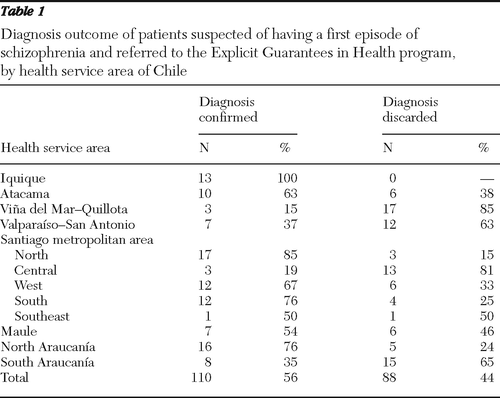
Table 1 Diagnosis outcome of patients suspected of having a first episode of schizophrenia and referred to the Explicit Guarantees in Health program, by health service area of Chile
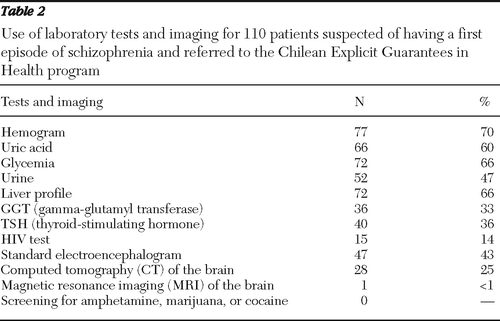
Table 2 Use of laboratory tests and imaging for 110 patients suspected of having a first episode of schizophrenia and referred to the Chilean Explicit Guarantees in Health program
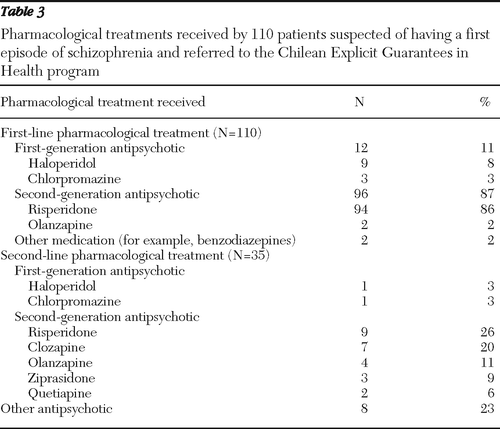
Table 3 Pharmacological treatments received by 110 patients suspected of having a first episode of schizophrenia and referred to the Chilean Explicit Guarantees in Health program
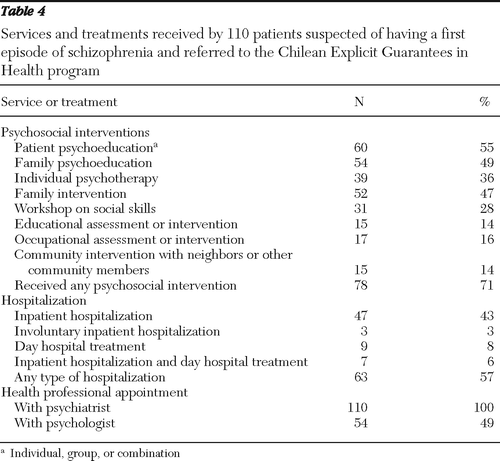
Table 4 Services and treatments received by 110 patients suspected of having a first episode of schizophrenia and referred to the Chilean Explicit Guarantees in Health program
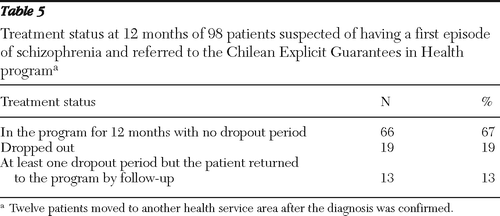
Table 5 Treatment status at 12 months of 98 patients suspected of having a first episode of schizophrenia and referred to the Chilean Explicit Guarantees in Health program



